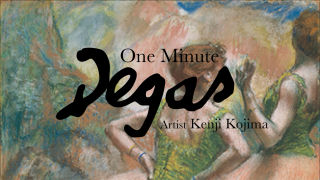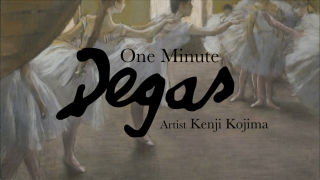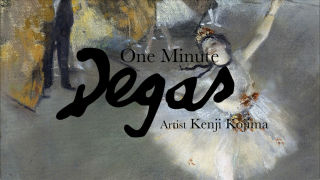
Pastel on Board or Paper by Edgar Degas
Artist: Kenji Kojima, 2023
Click on the image to select a video.




.jpg)

The colors are transformed into music by the algorithm.
it has artistic value even if you don't own it, or even if you do own it. Download: Two-Dancers, Pink and Green, Ballet Rehearsal, Ballet The Star Rosita Mauri The Hairdresser (The Toilet), Woman Combing Her Hair The artwork video can be shared for free. You can donate to the artist if you approve of the copied video as art. Even people who disapprove of art can have a copy. But it has no artistic value as they decided. |
|
Show: Japanese / 日本語
Hide: Japanese / 日本語
自然言語処理は、アートワーク作成における高度なコンピューター言語の頂点です。しかし、私はバイナリをその構築のための基本的な素材として想定しており、AIにおけるありふれたステレオタイプの芸術形式のコレクションを避けています。いまアーティストにできることは、AIで過去のデータを収集することではなく、AIが収集できないデータを生み出すことだ。 その1つは、バイナリを最も基本的なアート素材にすることです。データは連続した単一の値の集合であるためです。私は視覚と聴覚の深い関係に注目し、デジタルで表現される場合にはバイナリコードという共通の基盤を共有していることに気付きました。この原則は、視覚と聴覚を超えて、他のすべての形式のメディアに拡張されます。 今日に至るまで、あらゆる形式のメディアはバイナリ言語で表現されています。データを交換したり、別の形式に変換したりすることを考えました。これらのメディアをデジタル作品で表現すると、必然的にバイナリの領域に戻ります。 プロジェクトは、エドガー・ドガのパステル画を通して色と音楽の関係を探ります。 色彩を音符に変換するアルゴリズムは、ドガの描写からではなく、彼が使ったパステル・カラーの色チャートを音階の要素としています。視覚的な結果としてのカラー・チャートは、正方形のパターンで構成されており、1970 年代初頭のゲルハルト・リヒターの絵画「シリーズのカラーチャート」を思い出させるかもしれません。しかし、リヒターのカラーチャートは物理的なチューブ絵の具の混色の列挙で、眼球で統合される光の 3 原色(赤・緑・青)の役割を意図したものではありません。プロジェクトのアルゴリズムは、これらの色彩値をバイナリーで採取して、その値に従って12音階に割り振りします。得られた音階は、コンピューターピアノによって演奏されます。 Hide: Japanese / 日本語 Natural language processing is the pinnacle of advanced computer languages in artwork creation. However, I envision binary as the fundamental material for its construction, eschewing the collection of banal stereotyped art forms in AI. What artists can do now is not to collect past data with AI, but to create data that AI cannot collect. One of them is to make binaries the most basic art material. Because data is a collection of continuous single values. I looked at the deep relationship between sight and sound and realized that they share a common foundation in binary code when they are expressed digitally. This principle extends beyond the visual and auditory to all other forms of media. To this day, all forms of media are expressed in the language of binaries. I thought about possibly exchanging their data or transforming them into alternative forms. When we represent these media in digital works, we inevitably return to the realm of binaries. This project explores the relationship between color and music through the pastel drawings of Edgar Degas. The algorithm for converting colors into musical notes is not based on Degas' descriptions, but rather on the table of the pastel colors he used are elements of the scale. The resulting visual color chart consists of a pattern of squares and may recall Gerhard Richter's painting Color Chart of the Series from the early 1970s. However, Richter's color chart is an enumeration of the physical color mixtures of the tube colors and is not intended to reflect the role of his three primary colors of light (red, green, and blue) that are integrated with the eyeball. The project's algorithm collects these color values in binary random form and assigns them to a 12-tone scale. The resulting scale is played by a computer piano. Show: Kenji Kojima's Biography
Hide: Kenji Kojima's Biography
Kenji Kojima is a digital artist. He has been experimenting with the relationships between perception and cognition, technology, music, and visual art since the early 1990s. Primarily he has interested in the relationship between seeing and hearing. He was born in Japan and moved to New York in 1980. He painted egg tempera paintings that were medieval art materials and techniques for the first 10 years in New York City. His paintings were collected by Citibank, Hess Oil, and others. The personal computer improved rapidly during the 1980s. He felt more comfortable with computer art than paintings. He switched His artwork to digital in the early 1990s. His early digital works were archived in the New Museum - Rhizome, New York. He developed the computer software "RGB MusicLab" in 2007 and created an interdisciplinary work exploring the relationship between images and music. He programmed the software “Luce” for the “Techno Synesthesia” project in 2014. His digital art series was exhibited in New York, at media art festivals worldwide, including Europe, Brazil, and Asia, and the online exhibitions by ACM SIGGRAPH and FILE, etc. Anti-nuclear artwork “Composition FUKUSHIMA 2011” was collected in CTF Collective Trauma Film Collections / ArtvideoKoeln in 2015. He started the new series "The Musical Interpretation of Paintings and Photographs" which creates music from image data in 2021. LiveCode programmer. https://kenjikojima.com/ Hide: Kenji Kojima's Biography |
 Creative Commons License
Creative Commons License
Attribution-NonCommercial-NoDerivatives
You Can Download Kenji Kojima's Online Edition Videos (Public 1280x720) under Creative Commons License.
Please Support Kenji Kojima's Artworks.
日本からのドネーションは この文字列をクリック
日本から任意の金額のドネーションはできません。
https://kenjikojima.com/
Email: index@kenjikojima.com
/ Portraits with Dogs / What Madame Cézanne was thinking. / The Effect of Cataracts on Late Years Claude Monet. /